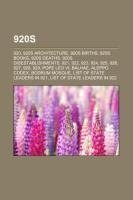
-
 Anglický jazyk
Anglický jazyk
920s
Autor: Source: Wikipedia
Source: Wikipedia. Pages: 38. Chapters: 920, 920s architecture, 920s births, 920s books, 920s deaths, 920s disestablishments, 921, 922, 923, 924, 925, 926, 927, 928, 929, Pope Leo VI, Balhae, Aleppo Codex, Bodrum Mosque, List of state leaders in 921, List... Viac o knihe
Na objednávku, dodanie 2-4 týždne
15.14 €
bežná cena: 17.20 €
O knihe
Source: Wikipedia. Pages: 38. Chapters: 920, 920s architecture, 920s births, 920s books, 920s deaths, 920s disestablishments, 921, 922, 923, 924, 925, 926, 927, 928, 929, Pope Leo VI, Balhae, Aleppo Codex, Bodrum Mosque, List of state leaders in 921, List of state leaders in 922, List of state leaders in 920, List of state leaders in 923, List of state leaders in 924, List of state leaders in 926, List of state leaders in 927, List of state leaders in 925, List of state leaders in 928, List of state leaders in 929, Croatian-Bulgarian battle of 927, Æthelweard, Abbey of Santo Domingo de Silos, Al-Mansur al-Qasim al-Iyyani, Battle of Valdejunquera, Athanasius the Athonite, Lothair II of Italy, Fortún Garcés of Pamplona, Conrad, Duke of Lorraine, 920s in poetry, Theophylact I, Count of Tusculum, Reginar III, Count of Hainaut, Battle of Pegae, Church of San Salvador de Priesca, Thietmar, Margrave of Meissen, Savaric II, Oliba Cabreta, Conrad of Burgundy, Adalbert I of Ivrea, Ahmad ibn A'zham, Battle of Firenzuola, Aryabhata II, Battle of Soissons. Excerpt: Balhae (698 - 926) (¿¿¿¿¿ also ¿¿¿¿¿ in Russian; Korean pronunciation: ) was a Korean kingdom established after the fall of Goguryeo that existed during the North South states period of Korea along with Unified Silla. After Goguryeo's capital and southern territories fell to Unified Silla, Dae Jo-yeong, a former Goguryeo general, whose father was Dae Jung-sang, established Jin (¿, Zhen in Chinese), later called Balhae. It was a successor state to Goguryeo. Balhae occupied southern parts of Manchuria (Northeast China) and Primorsky Krai, and the northern part of the Korean peninsula. It was defeated by the Khitans in 926, and most of its northern territories were absorbed into the Liao Dynasty while the southern parts were absorbed into Goryeo. The earliest extant recorded mention of Balhae come from the Book of Tang, which was compiled between 941 to 945. Southern Manchuria and northern Korea were previously the territory of Goguryeo, one of the Three Kingdoms of Korea. Goguryeo fell to the allied forces of Silla and the Tang Dynasty in 668. The Tang annexed much of western Manchuria, while Silla unified the Korean peninsula south of the Taedong River and became Unified Silla. In the New Book of Tang, it was recorded that the founder of Balhae, Dae Joyeong (¿¿¿) was a former Goguryeo general. The second King Mu (r. 719-737), who felt encircled by Tang, Silla and Black Water Mohe along the Amur River, attacked Tang with his navy in 732 and successfully attacked and killed a Tang prefect based on the Shandong Peninsula. Later, a compromise was forged between Tang and Balhae, which resumed tributary missions to Tang. He also sent a mission to Japan in 728 to threaten Silla from the southeast. Balhae kept diplomatic and commercial contacts with Japan until the end of the kingdom. Balhae dispatched envoys to Japan 34 times, while Japan sent envoys to Balhae only 13 times. Because of its proximity to many powerful states, Balhae became a buffer zone for the region. The th
- Vydavateľstvo: Books LLC, Reference Series
- Rok vydania: 2014
- Formát: Paperback
- Rozmer: 246 x 189 mm
- Jazyk: Anglický jazyk
- ISBN: 9781156005422







 Nemecký jazyk
Nemecký jazyk 
 Ruský jazyk
Ruský jazyk 



